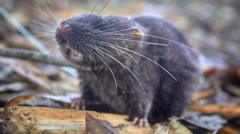The Alto Mayo area, rich in varied ecosystems and Indigenous territories, is experiencing pressures from deforestation and agricultural practices due to its relatively high population density. Conservation International highlighted the significant role this region plays in preserving cultural and biodiversity heritage. Awajún woman Yulisa Tuwi noted that the report empowers the Awajún community to safeguard their cultural identity, natural resources, and territory while fostering a deeper understanding of local ecosystems.
Among the remarkable discoveries were a new type of dwarf squirrel measuring just 14 centimeters, several fish species, three new amphibians, and 10 different butterflies. Specifically, the "blob-headed" fish possesses an enlarged head – a feature previously unknown to scientists – while the newly identified dwarf squirrel is notable for its small size and vibrant chestnut-brown color.
The team also identified a new species of spiny mouse, named for its stiff guard hairs that mimic hedgehog spines, and a rare amphibious mouse feeding on aquatic insects, part of a group of semi-aquatic rodents. Noteworthy is the small, arboreal opossum possessing large ears for acute hearing, showcasing the diversity of life forms discovered in this expedition.
As conservation efforts continue in regions like Alto Mayo, the synergy between indigenous communities and scientific research proves vital in preserving both nature and cultural heritage, signalling a collaborative path forward.
With potentially up to 48 additional species awaiting confirmation, this expedition reinforces the urgency of protecting Peru's ecological and cultural landscapes for future generations.
Among the remarkable discoveries were a new type of dwarf squirrel measuring just 14 centimeters, several fish species, three new amphibians, and 10 different butterflies. Specifically, the "blob-headed" fish possesses an enlarged head – a feature previously unknown to scientists – while the newly identified dwarf squirrel is notable for its small size and vibrant chestnut-brown color.
The team also identified a new species of spiny mouse, named for its stiff guard hairs that mimic hedgehog spines, and a rare amphibious mouse feeding on aquatic insects, part of a group of semi-aquatic rodents. Noteworthy is the small, arboreal opossum possessing large ears for acute hearing, showcasing the diversity of life forms discovered in this expedition.
As conservation efforts continue in regions like Alto Mayo, the synergy between indigenous communities and scientific research proves vital in preserving both nature and cultural heritage, signalling a collaborative path forward.
With potentially up to 48 additional species awaiting confirmation, this expedition reinforces the urgency of protecting Peru's ecological and cultural landscapes for future generations.


















